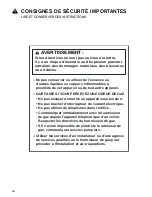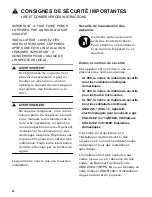
11
Installation Procedure
en-us
Connect Gas Supply
The appliance is shipped from the factory for use with
natural gas. It must be converted for use with propane. A
qualified technician or installer must do the conversion.
Before connecting the appliance, please check whether
the local connection conditions such as gas type and gas
pressure match the appliance settings.
Make sure the gas supply is turned off at the manual shut-
off valve before connecting the appliance.
The gas connection must be in a location that permits
access to the manual shut-off valve and which, if
applicable, is visible after opening the door of the
cabinet.
The flexible gas line must not come into contact with
moving parts of the fitted unit (e.g. drawers) or be laid in
areas where it could become trapped or damaged.
The flexible gas line must not come into contact with a
cooktop, oven, dishwasher, refrigerator, washing
machine, hot water pipe, radiator or any other appliance
installed in the vicinity of the gas cooktop.
The flexible gas line must not be subject to rubbing,
vibrations, kinking or any other kind of deformation. It
should be checked along its entire length with the
cooktop in the installation position.
SERVICER INFO ONLY
Connect the gas supply using the ½" U.S.A. elbow and
the fiber gasket supplied with the unit. The shorter,
nontapered thread fits into the threaded nut on the
cooktop. The longer, tapered U.S.A. thread is for the
incoming gas supply. Vent the gas line, check for leaks.
9
CAUTION
The gas pressure regulator is supplied with the
unit and comes set for natural gas.
Connect Electrical Supply
Before connecting supply cord to wall receptacle, make
certain that gas shutoff valve and all burner controls are
in OFF position.
Electrical connection (AC 110-120 V) is established by
means of a connecting cord with a grounding contact
plug connected to a grounded socket, which must also
be accessible after installation of the gas cooktop.
Burner Cap Placement
The burner parts must be properly placed for the cooktop
to function properly. If the burner parts are not properly
placed, one or more of the following problems may occur:
▯
Burner flames are too high.
▯
Flames shoot out of burners.
▯
Burners do not ignite.
▯
Burner flames light unevenly.
▯
Burner emits gas odor.
Placing Burner Parts
After electrical connection is complete, assemble the
burner parts correctly and evenly. When assembling the
burner parts, make sure that the burner head is placed on
the base in such a way that the prongs of the burner cap
fit snugly into the groove of the burner base.
Checking Burner Cap Placement
Check to make sure that there is no gap between the
burner parts. You may gently try to move the burner parts
from side to side to check if they are properly placed.
Check the Installation
Check operation of electric igniters. Check flame
characteristics. Flame should be blue with no yellow tip.
Yellow Flames:
Further adjustment is required.
Yellow Tips on Outer Cones:
Normal for LPG Gas.
Soft Blue Flames:
Normal for Natural Gas.
If the flame is completely or mostly yellow, verify that the
regulator is set for the correct fuel. After adjustment,
retest.
Some yellow streaking is normal during the initial start-
up. Allow unit to operate 4-5 minutes and re-evaluate
before making adjustments.












































